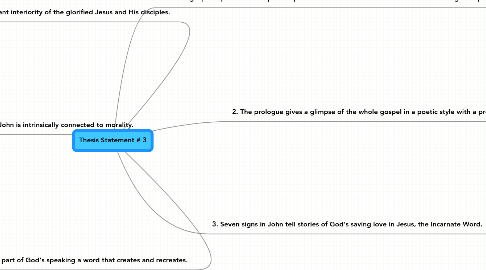
1. 4. These small signs were part of God's speaking a word that creates and recreates.
1.1. God's word involves discourse and man's participation (faith)
1.2. God's speaking a word needs to be delivered to an "audience"
1.2.1. Conversely, the "audience" needs to receive this word in and through faith, as evidenced by the people acting upon this word
1.3. God's speaking a Word is for God to be glorified -- it is also a sign as much as it is a miraculous utterance
2. 5. Spirituality in the gospel of John is intrinsically connected to morality.
2.1. evidenced by the various stories of Jesus not following the letter of the law
2.1.1. he performed miracls on Sabbath day for which he was persecuted but we see the morality of taking action in order to save a life
2.1.2. morality is all about valuing life
2.1.2.1. moral obligation is a relational obligation
2.1.3. SPIRIT (spirituality) of the law as opposed to the LETTER
2.1.3.1. focuses of interiority of the faith that takes place through reflection, prayer, and study of the word
3. 6. It is rooted in the covenant interiority of the glorified Jesus and His disciples.
3.1. Commitment between Jesus and disciples was based on faith and sometimes even when they could not grasp the entirety of what he was doing, they believed and it was good
3.2. commitment to Jesus is an involving process and not an automatic response as evidenced by some stories in the gospel of John
3.2.1. people did not simply believe
3.2.2. they took time and personal reflection before they committed themselves to him
4. 2. The prologue gives a glimpse of the whole gospel in a poetic style with a profound philosophical and theological content.
4.1. "All things came to be through him and without him nothing came to be. What came to be through him was life, and this life was the light of the human race; the light shines in the darkness and the darkness has not overcome it."
4.1.1. God sent his son into the darkness to provide light for the human race (poetic) -- metaphorical yet literal consequences
4.1.1.1. Poetic style (steps depiction)
4.1.2. deals with the Light and Word as Truth (philosophical) yet with Christ as the foreground/background of this truth (theological which presupposes a dimension of faith)
5. 1. John's gospel expresses the important place of commitment to God in Jesus Christ through the power of the Holy Spirit.
5.1. last gospel to be written (100AD) in Asia minor, focus is on the Word incarnate
5.2. sets itself apart from the three synoptic gospels because it is most symbolic
5.3. Jesus Christ reveals God so we may believe in Him through the power of the Holy Spirit
5.3.1. Symbolized through the Dove during Christ's Baptism
5.4. focuses on Jesus going from city to city to make believers out of men
5.4.1. Jesus used signs through the power of the Holy Spirit
5.4.2. his going from city to city was a sign of his commitment and love for the people he was going to save
6. 3. Seven signs in John tell stories of God's saving love in Jesus, the Incarnate Word.
6.1. the seven signs
6.1.1. wedding at cana
6.1.1.1. 2: 1-12
6.1.2. Healing of the official's son
6.1.2.1. 4:46-54
6.1.3. the pool at Bethesda
6.1.3.1. 5:1-18
6.1.4. Feeding of the multitude
6.1.4.1. 6:1-15
6.1.5. Jesus walks on water
6.1.5.1. 6:16-21
6.1.6. Jesus heals the man born blind
6.1.6.1. 9:1-41
6.1.7. Raising of Lazarus
6.1.7.1. 11:1-44
6.2. Jesus goes beyond 'laws' and humbles himself to save
6.2.1. he takes the initiative to heal despite our sinfulness
6.2.2. Jesus heals on a Sabbath despite it being His ordained time of rest
6.2.2.1. God is merciful and values life over tradition
